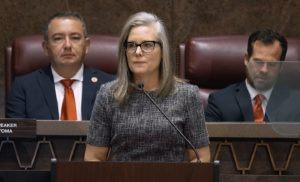Conservative justices scoff at Maine’s exclusion of religious schools from tuition-assistance program
The Supreme Court heard oral…
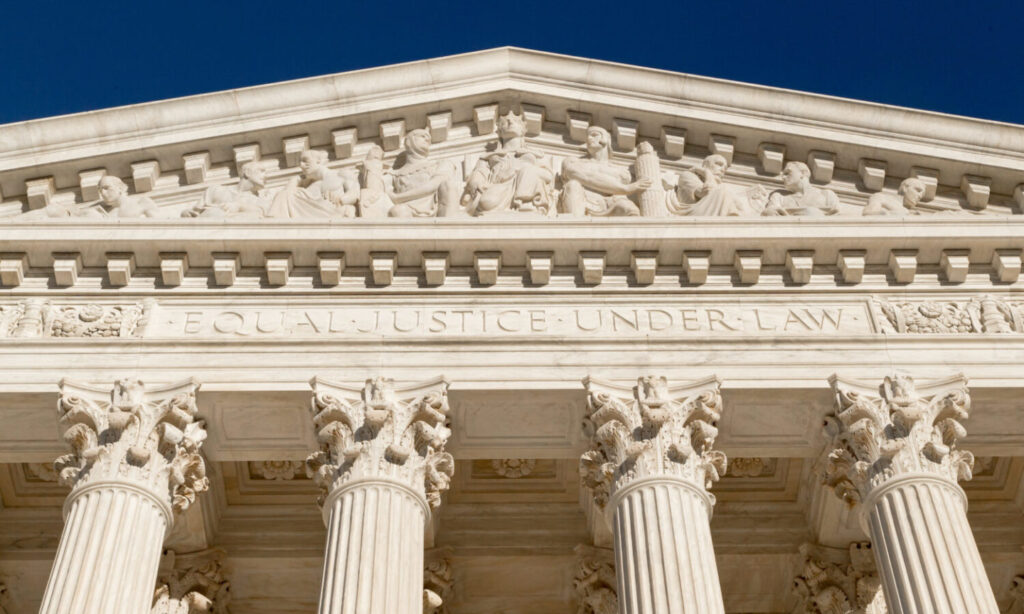
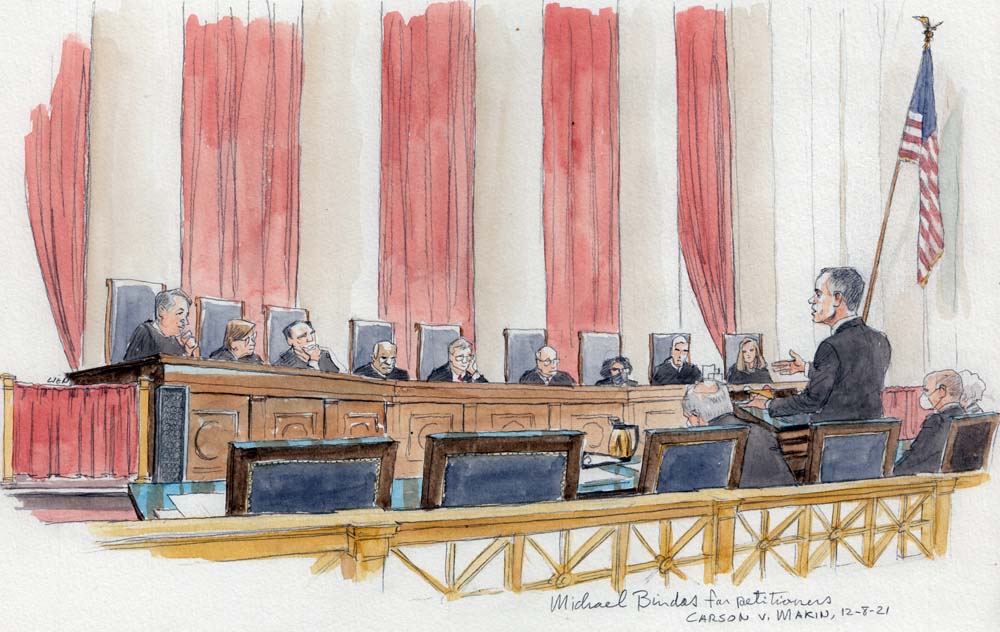
Michael Bindas argues on behalf of parents who want to send their children to religious schools. (Art Lien)
The Supreme Court heard oral arguments on Wednesday in a challenge to a Maine program that pays tuition for some students to attend private school when their own school district does not operate a public secondary school. Two Maine couples argue that the state’s refusal to provide funds for students to attend schools that provide religious instruction violates the Constitution, and after nearly two hours of oral argument the court’s conservative justices appeared to agree. Although the lawyer representing Maine on Wednesday emphasized that the court’s decision would directly affect only a small number of Maine families, a ruling for the parents could mean that state and local governments that opt to subsidize private schools would be required to allow families to use taxpayer funds to pay for religious schools.
At issue in Carson v. Makin is the system that Maine uses to give school-aged children the opportunity to receive a free public education. Because parts of the state are rural and sparsely populated, not all school districts run their own secondary schools. Instead, some districts make arrangements with specific private schools or other public schools to take their students. And other school districts allow their students to choose their own public or private school – either in Maine or out of state – and pay their tuition. However, the state only allows tuition payments under the program to go to private schools that are “nonsectarian” – that is, schools that do not provide religious instruction.
Arguing on behalf of the parents who want to be able to use funds from the state’s tuition-assistance program to send their children to religious schools, lawyer Michael Bindas told the justices that “religious schools teach religion. It is part of what they do. It is also part of who they are.” Referring to the 2020 decision in Espinoza v. Montana Department of Revenue, in which the court held that a state cannot exclude families or schools from participating in programs to provide public funding for private schools because of a school’s religious status, but did not decide whether states could exclude families or schools when the money would be used for religious purposes, Bindas stressed that the state’s refusal to allow his clients to participate in the tuition-assistance program is unconstitutional regardless of whether the state discriminates based on the schools’ religious status or because they teach religion.
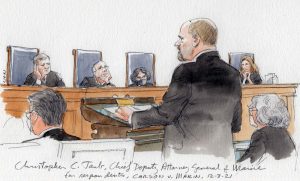
Christopher Taub, chief deputy attorney general of Maine. (Art Lien)
Representing Maine, the state’s chief deputy attorney general, Christopher Taub, countered that the tuition-assistance program does not discriminate at all. Instead, he told the justices, it is intended to provide students who live in school districts without their own secondary schools with the equivalent of the education that they would have received in a public school – which means, he said, a “religiously neutral” one.
The court’s liberal justices echoed this idea in their questions for Bindas, with Justice Sonia Sotomayor noting that parents who live in districts with their own public schools don’t have the option of participating in the tuition-assistance program at all. If those parents want their children to have religious education, Sotomayor emphasized, they would have to pay for it themselves. Therefore, Sotomayor continued, parents who live in school districts that do not have their own public schools “are put to the same choice that every other parent in Maine is put to: Either get a free public secular education or pay for your religious training. They’re being treated as everybody else is.”
Justice Elena Kagan made a similar point. Maine’s tuition-assistance program, she observed, “is a default program for a very small number of students living in isolated areas.” To address this unique situation, she reasoned, the state has created this “extremely cabined program” that the court arguably should not view through the same lens as more traditional school-choice programs.
But Kagan’s conservative colleagues repeatedly disagreed with her, beginning with the state’s premise that the tuition-assistance program (and its exclusion of sectarian schools) was intended to provide the “rough equivalent” of a public education. Justice Clarence Thomas expressed bewilderment at Taub’s insistence that the “rough equivalent” of a public education was an education that does not promote one particular set of religious beliefs at the exclusion of another. Perhaps, Thomas suggested, the focus of a public education should be on academic interests instead.
Justice Samuel Alito noted that parents could use the tuition-assistance program to send their children to elite New England boarding schools like Phillips Andover, Phillips Exeter and Miss Porter’s School. Are those, Alito asked Taub, really the equivalent of a public education?
And Justice Amy Coney Barrett observed that not all schools are alike. For example, she told Taub, private schools are sometimes single-sex, even though public schools are normally co-educational.
But even beyond the premise of Maine’s argument, several of the court’s conservative justices made comments and asked questions indicating that they regarded the state’s exclusion of schools that teach religion as unconstitutional discrimination. Chief Justice John Roberts outlined a hypothetical involving two religious schools, only one of which is obligated by its religion to educate students in its faith. When Taub told Roberts that the school that educated students in its faith would not receive funding under the Maine program, while the other would, Roberts concluded that funding for the schools hinged on the beliefs of the two different religions. “And we have said,” he stressed, “that is the most basic violation of the” Constitution – “for the government to draw distinctions between religions based on their doctrines.”
Alito described a different religious school with religious beliefs much like the Unitarian Universalist Church that are infused into the school community – for example, that all people are created equally. When Taub seemed to indicate that such a school might be eligible to receive funds under the Maine program, Alito bridled. Unless you can say that you would treat the Unitarian Universalist school the same way as a Catholic or Orthodox Jewish school, Alito cautioned Taub, “I think you’ve got a problem.”
Justice Neil Gorsuch chafed at the suggestion that families who wanted a religious education for their children could send their children to religious instruction after school or on weekends. When the government creates a program like Maine’s, he emphasized, to argue that you don’t have to choose between participation in the program and your religion because you can send your children to Sunday school seems to favor religions for whom that is an adequate substitute and discriminate against those for whom it is not.
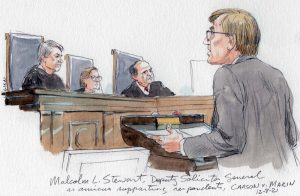
Malcolm Stewart, U.S. deputy solicitor general, argues in support of Maine. (Art Lien)
Justice Brett Kavanaugh also weighed in. He told Malcolm Stewart, the deputy U.S. solicitor general who appeared on behalf of the United States as a “friend of the court” supporting Maine, that the arguments by the federal government and Maine boiled down to the suggestion that, in a school district without a public school, one family could send their children to a secular private and receive the tuition assistance, while a neighbor who sends her child to a religious private school could not. “That’s just discrimination on the basis of religion right there at the neighborhood level,” Kavanaugh concluded.
Some conservative justices also expressed concern that excluding schools that provide religious instruction would require state officials to get involved in examining a religious school’s curriculum to determine whether it is eligible to participate in the program – potentially creating its own constitutional problems. Taub assured the justices that “these are easy calls to make,” in no small part because religious schools do not try to hide the fact that they are religious. But that did not necessarily mollify the justices.
The liberal justices pressed two arguments, neither of which seemed to get much traction. The first was the contention – made by both the United States and Maine – that the parents do not have a legal right to sue when the schools have not committed to accept public funds even if the law were struck down. Kagan asked Bindas whether the parents could bring their case even if all of the schools that meet their religious requirements make clear that they won’t take the money. Bindas answered that they could, stressing that the injury needed to have a right to sue comes from the denial of an opportunity even to seek out such a school.
The second argument, made primarily by Kagan but also by Justice Stephen Breyer, was the idea that – particularly because the schools at issue in this case only hire born-again Christians as teachers and won’t hire LGBTQ teachers or admit LGBTQ students – although “some states might love to have” programs that fund all kinds of private schools, “others think it would be very divisive to do so.” Therefore, she continued, the court has often discussed the idea of “play in the joints” when it comes to religion, to allow state and local governments some flexibility rather than requiring everyone to follow the same model.
Kavanaugh saw things differently. He suggested that excluding someone who is religious from a state program could also create a sense of inferiority and division.
A decision in the case is expected by summer.
This article was originally published at Howe on the Court.


